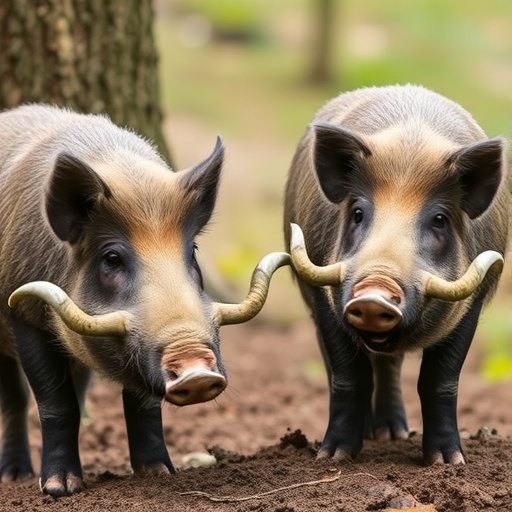In a breakthrough scientific study that reshapes our understanding of infectious disease dynamics, researchers have identified wild boars as a critical nexus in the circulation of viruses between wildlife populations and domestic animals. The intricate web of pathogen transmission has long eluded definitive mapping, but this novel investigation unfolds a detailed picture of how wild boars act not merely as passive carriers but as active nodes facilitating viral exchange across species barriers, thereby amplifying the risks of zoonotic spillover events and livestock epidemics.
By employing sophisticated network analysis techniques combined with extensive field sampling, the study conducted by Tu, Sun, Wang, and colleagues meticulously dissects the role of wild boars within complex ecological networks. Traditionally considered as potential reservoirs for various pathogens, wild boars have now been demonstrated to occupy a pivotal position that interlinks otherwise ecologically segregated groups of wildlife and domesticated animals. This finding challenges prevailing assumptions that focus predominantly on direct contact among domestic animal herds as the primary vectors for disease propagation.
The research leverages next-generation sequencing technologies alongside ecological modeling to unravel viral circulation patterns at a granular level. Data collected across diverse geographical zones reveal that wild boars harbor a rich virome comprising multiple RNA and DNA viruses, some of which overlap with pathogens affecting domestic species like pigs, cattle, and small ruminants. These overlapping viral signatures imply that wild boars facilitate interspecies transmissions, thereby acting as bridges facilitating pathogen spillover events that may culminate in outbreaks or endemic viral persistence in agricultural settings.
Furthermore, the spatial and temporal dynamics of wild boar populations, characterized by wide-ranging movements, seasonal aggregations, and interface interactions with human-managed landscapes, substantially enhance their role as mobile reservoirs. The study illuminates how these behavioral and ecological traits increase contact rates with both wild fauna and farm animals, creating hotspots for viral recombination and genetic exchange processes that can give rise to emergent viral variants with altered virulence or host tropism.
One particularly striking aspect of the research lies in its network-theoretic approach. By conceptualizing virus circulation as a system of nodes and edges representing host species and transmission pathways respectively, the authors identify wild boars as super-spreaders within this system. Their removal or effective management could significantly disrupt pathogen transmission chains. Conversely, ignoring their role may undermine efforts to control the spread of viral diseases affecting both biodiversity and agricultural productivity.
The impact of such viral circulation is not confined to animal health alone but carries profound implications for public health security given the zoonotic potential of many viruses. The study emphasizes that wild boars’ centrality in virus networks increases opportunities for novel zoonoses to arise. Pathogens circulating silently at the wildlife-livestock interface can adapt to new hosts, subsequently crossing into human populations under favorable ecological or socio-economic conditions.
Moreover, the findings prompt a reevaluation of current surveillance strategies which often marginalize wild suids, focusing instead on domestic herds. The authors advocate for integrated One Health approaches that encompass wildlife monitoring, especially of wild boar populations, combining molecular diagnostics, ecological surveillance, and epidemiological modeling to preemptively identify and mitigate emerging viral threats.
Methodologically, the research sets a new benchmark by combining longitudinal sampling with advanced bioinformatics pipelines capable of detecting low-prevalence viruses and reconstructing transmission networks. This multidimensional data synthesis allows mapping of not only virus presence but also directionality and frequency of cross-species transmissions, affording unprecedented resolution in understanding viral ecology within natural and anthropogenic environments.
The ecological insights derived also suggest interventions such as targeted vaccination campaigns, habitat management to reduce contact interfaces, and strategic population control of wild boars where appropriate. Such measures must be carefully balanced with conservation and ethical considerations but represent pragmatic avenues to reduce viral propagation risks and safeguard animal and human health.
The study further highlights how environmental changes driven by human activities, including land-use alteration, urban sprawl, and climate variability, are reshaping wild boar behavior and population dynamics, potentially intensifying their epidemiological importance. As habitats fragment and resources become patchy, wild boars may increasingly encroach on farms, amplifying interaction opportunities and viral exchange.
Underpinning the research is a call for global cooperation in data sharing and cross-disciplinary collaboration, recognizing that the virus circulation landscape transcends national borders and demands coordinated responses. Wild boars migrate over large territories crossing political boundaries, making unilateral efforts ineffective without a combined multinational framework inclusive of wildlife management, veterinary public health, and environmental conservation entities.
The revelation of wild boars as indispensable nodes in virus transmission networks between wildlife and domestic animals thus represents a paradigm shift that prompts urgent reevaluation of disease ecology models. It beckons a holistic reconsideration of pathogen control frameworks that have been historically fragmented across sectors, advocating for a systemic, interconnected vision to tackle emerging infectious diseases more effectively.
In conclusion, this comprehensive research elucidates the multifaceted and dynamic role of wild boars, positioning them as a linchpin in viral ecology at the interface of natural and human-modified ecosystems. By leveraging cutting-edge molecular tools, ecological analytics, and network theory, the study paves the way toward more robust predictive models, targeted interventions, and integrative health strategies to mitigate impending viral threats that transcend species boundaries. As human-wildlife interactions intensify under global change scenarios, acknowledging and addressing the node role of wild boars within viral circulation frameworks is imperative to safeguard both animal and human populations.
Subject of Research: Virus circulation dynamics involving wild boars as key nodes in transmission networks between wildlife and domestic animals.
Article Title: Node role of wild boars in virus circulation among wildlife and domestic animals.
Article References:
Tu, Z., Sun, H., Wang, T. et al. Node role of wild boars in virus circulation among wildlife and domestic animals. Nat Commun 16, 8938 (2025). https://doi.org/10.1038/s41467-025-64019-4
Image Credits: AI Generated
Tags: ecological modeling in virologyinfectious disease dynamicslivestock epidemic risksnext-generation sequencing in disease researchpathogen circulation networksrole of wild boars in pathogen transmissionunderstanding zoonotic spillover eventsviral exchange between speciesviral reservoirs in wildlifewild boars as virus spreaderswildlife and livestock interactionszoonotic disease transmission





